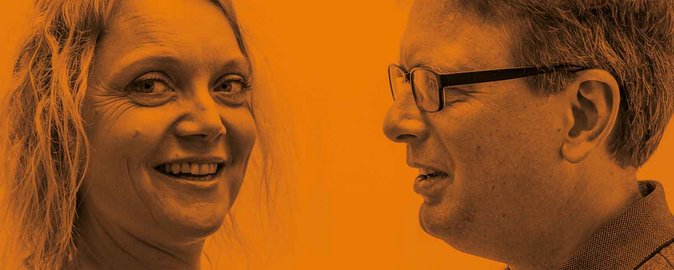- Education
-
Research
Current research
Talent
-
Collaboration
Businesses
Government agencies and institutions
Alumni
-
About AU
Organisation
Job at AU
The AU interdisciplinary centre Interacting Minds is generating new insight into what happens to people when they interact with each other. What goes on in their brains? And what happens to their feelings? And how does communication affect all this?
2013.09.10

Professor Andreas Roepstorff has studied both biology and anthropology, and divides his research work equally between these two fields. He is director of Interacting Minds, an interdisciplinary centre with 40 affiliated researchers from a wide range of fields. Vibeke Fulgsang Bliksted is a psychologist who has worked with young schizophrenia patients for nine years at OPUS, a clinic for young schizophrenia patients , at Aarhus University Hospital. She is also an associated researcher at Interacting Minds (IMC). She recently completed her PhD.
The AU interdisciplinary centre Interacting Minds was established in August 2012. The centre has been quick to develop research collaboration across traditional disciplinary boundaries.
»Humanists discover that they can use biologists, physicists and psychologists – and vice versa. The humanists bring new ideas to clinical and scientific research areas,« explains Professor Andreas Roepstorff, director of Interacting Minds. Roepstorff is himself both an biologist and an anthropologist.
»In fact, research partnerships that weren’t even included in our research plan have already developed. The researchers find out on their own that they can draw on each other across specialisations and disciplines. What’s at the core of what we’re doing is the object of our research – human interaction – and that’s what we have in common. Completely new forms of research collaboration and projects sprout from this,« says Roepstorff.
Although the researchers affiliated with the centre have widely different academic backgrounds, they share a common approach: curiosity and willingness to break down traditional disciplinary boundaries, working together to reach a deeper understanding of human interaction.
Andreas Roepstorff has always been deeply interested in interdisciplinary research and in understanding the mechanisms that come into play when people interact with each other.
»Understanding human interaction is essentially a matter for the humanities. But it also has significant ramifications for the social sciences and medicine. If, for example, we are to understand all the complexities associated with mental disorders, it is clearly necessary to bring in knowledge from health sciences, but in addition biology, psychology, anthropology and sociology are all relevant if we are to investigate and understand the issue in depth,« says Andreas Roepstorff. »We can explore human interaction in all its aspects and illuminate it from several angles,” explains Roepstorff.
Interdisciplinary research centres
Aarhus University has established seven interdisciplinary research centres. The fundamental idea is to create an oasis in which to establish new research partnerships, where strong researchers at Aarhus University can collaborate with colleagues from other areas of specialisation and freely follow uncharted potential in a new, joint direction.
Interdisciplinary research is understood as research, where strong research groups from different main academic areas join forces and integrate information, data, methods, concepts and theories with the aim of conducting basic research or resolving problems, which require combined knowledge from multiple research disciplines.
The seven interdisciplinary research centres at AU
Interdisciplinary Nanoscience Center (iNANO)
MINDLab
Centre for iSequencing (iSEQ)
Centre for integrated Registerbased Research (CIRRAU)
Arctic Research Centre (ARC)
Interacting Minds Centre (IMC)
Participatory Information Technology Centre (PIT)